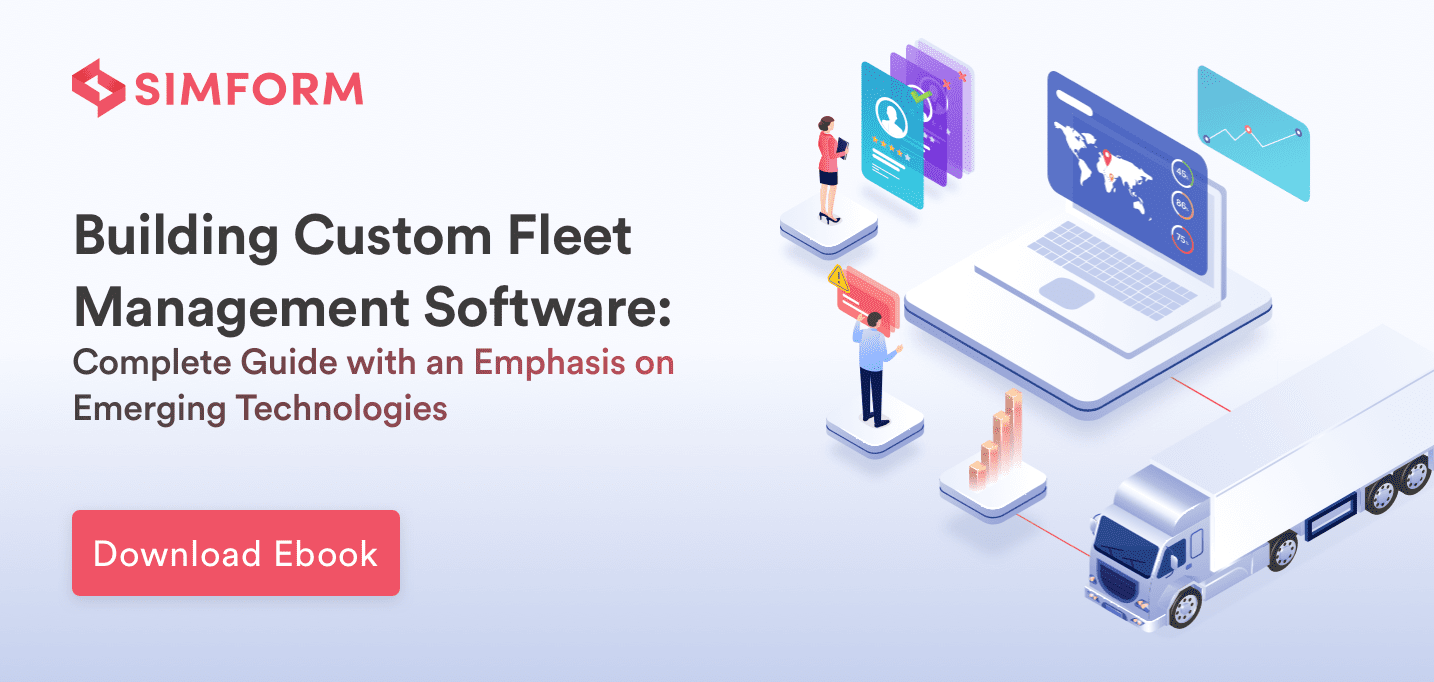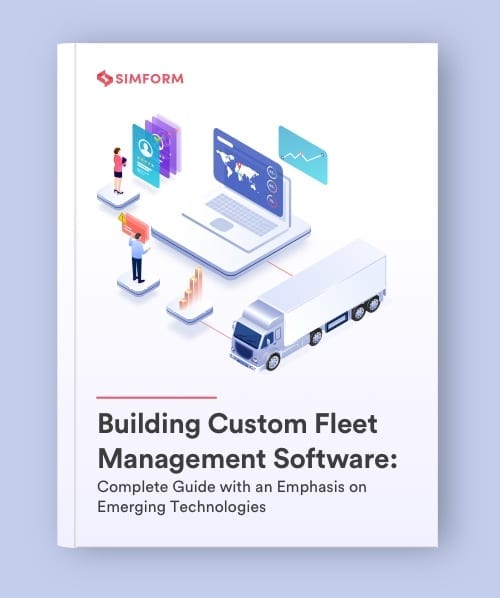Revolutionary, scalable, innovative, futuristic, cost-effective, and disruptive are some adjectives usually associated with modern-day fleet management technologies. But this wasn’t always the case. We’ve come a long way from when fleet management solutions were only a means for tracking vehicles. Back then, GPS technology was the mainstay of solutions, and fleet managers were more than happy with this extra bit of information to manage daily operations.
However, the present situation demands more comprehensive software solutions to survive, nay, thrive in this highly competitive fleet-management ecosystem. Efficiency in fleet management reflects on the bottom line of your company. And to become more efficient, you need an almighty tool that can deal with vehicle management, routing, maintenance, driver safety, driver management, security, fuel management, payment management, and other challenges popping up in your mind while reading this.

Kristofer Bush, VP of Marketing- LeasePlan USA, told Fleet Financials – “Change is coming, no question. My advice would be twofold. One, listen to your drivers. After all they are the ones that need to be mobile. Gather their feedback. Ask them what makes sense when it comes to getting the job done. And secondly, partner with companies that are forward thinking and looking to the future.”
Thankfully, there’s been an influx of multiple technologies objectively addressing these challenges and even helping you stay on top of the ones in future. In this chapter, we’d be looking at some of these emerging tech, and how they can bring efficacy to your fleet-management operations. Let’s dive right in:
Editor’s note – IoT, Advance telematics, and Big data are the few emerging technologies in Fleet Management Systems and are changing the way how the system operates. If you want to build a fleet management system using such emerging technologies, don’t hesitate to explore our software development services.
Advances in Telematics
Telematics refers to asset-and-vehicle tracking using GPS, sensors, dashboard cams and various other tools and techs. Its inception can be traced back to the 1960s as a military tech used to keep track of nuclear submarines. Telematics has improved by leaps and bounds since then and has become seemingly ubiquitous across fleet-management systems.
You may wonder then – how does an omnipresent ‘prehistoric’ tech qualify as an emerging technology for fleet management? The answer lies in the perpetually increasing number of features in its repertoire. Be it a truck that’s hauling perishables across state borders or a van carrying crew and equipment for a local pest-control business, any logistics vehicle on the road is a platform full of sensors and logging devices. Telematics allows your fleet manager to effectively harness all kinds of information from sensors and devices and improve overall productivity, safety, and compliance.
Louis Vella, telematics product development manager at ARI, echoed the dominance of telematics while sharing thoughts on future fleet management trends with Automotive Fleet – “The fleet management space is buzzing with a variety of new technologies, but telematics and advanced analytics continue to be the fuel that drives innovation. Telematics and advanced analytics are driving efficiency today and are poised to continue to do so for the foreseeable future.”
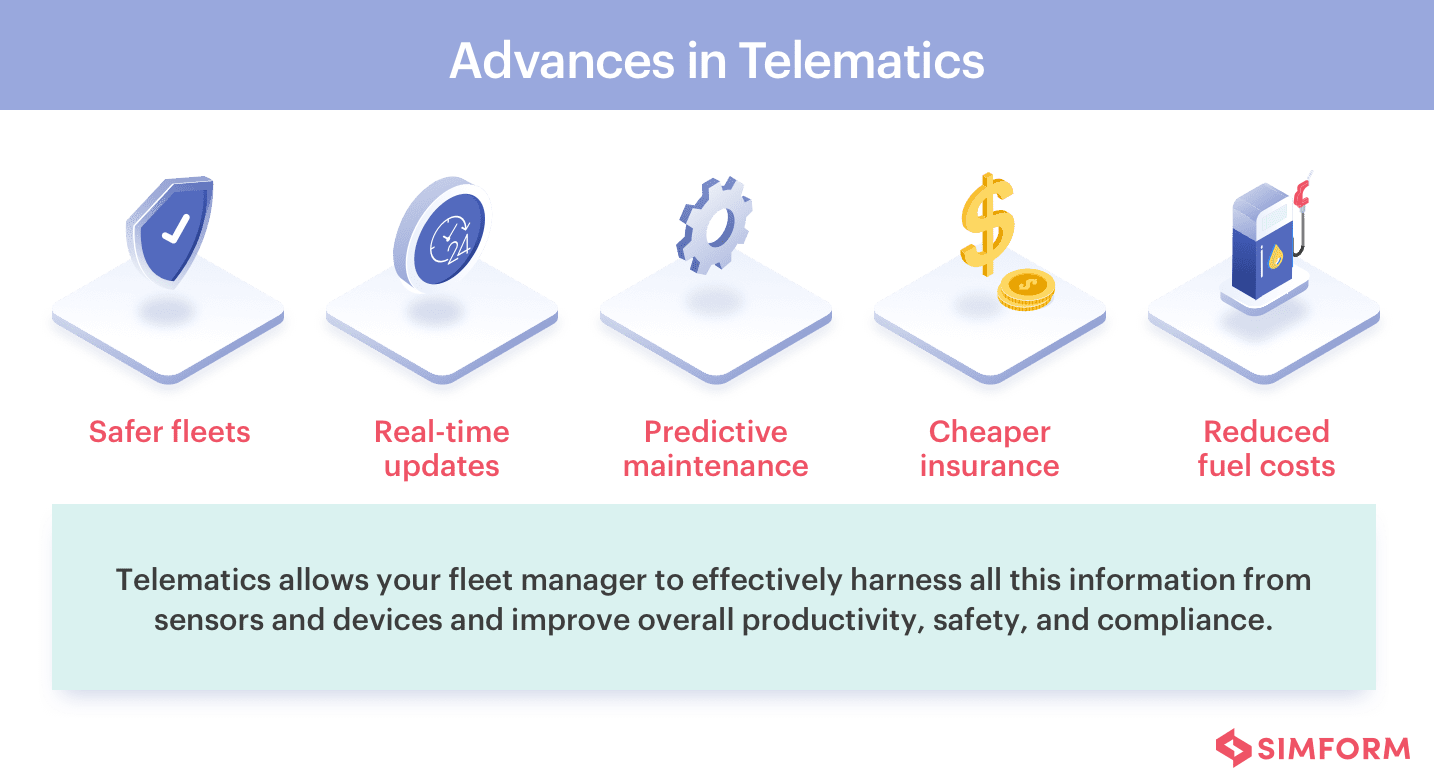
Telematics use cases
Telematics touches upon almost every aspect of fleet management and, therefore, brings a whole plethora of use cases for your fleet managers. Let’s look at some of the ways this combination of telecommunications and informatics is pushing the envelope for effective fleet management:
Real-time updates
Telematics has kicked the guessing game out of the fleet-management equation with real-time updates. Now, the managers can be a lot more flexible in day-to-day operations, and your business could get more profitable with smartly managed fleets. They can monitor current status of vehicles and update customers with an accurate timeline for the delivery of products. Instant monitoring also invites better reactions to external factors like bad-weather conditions, temporary roadblocks, and modified orders.
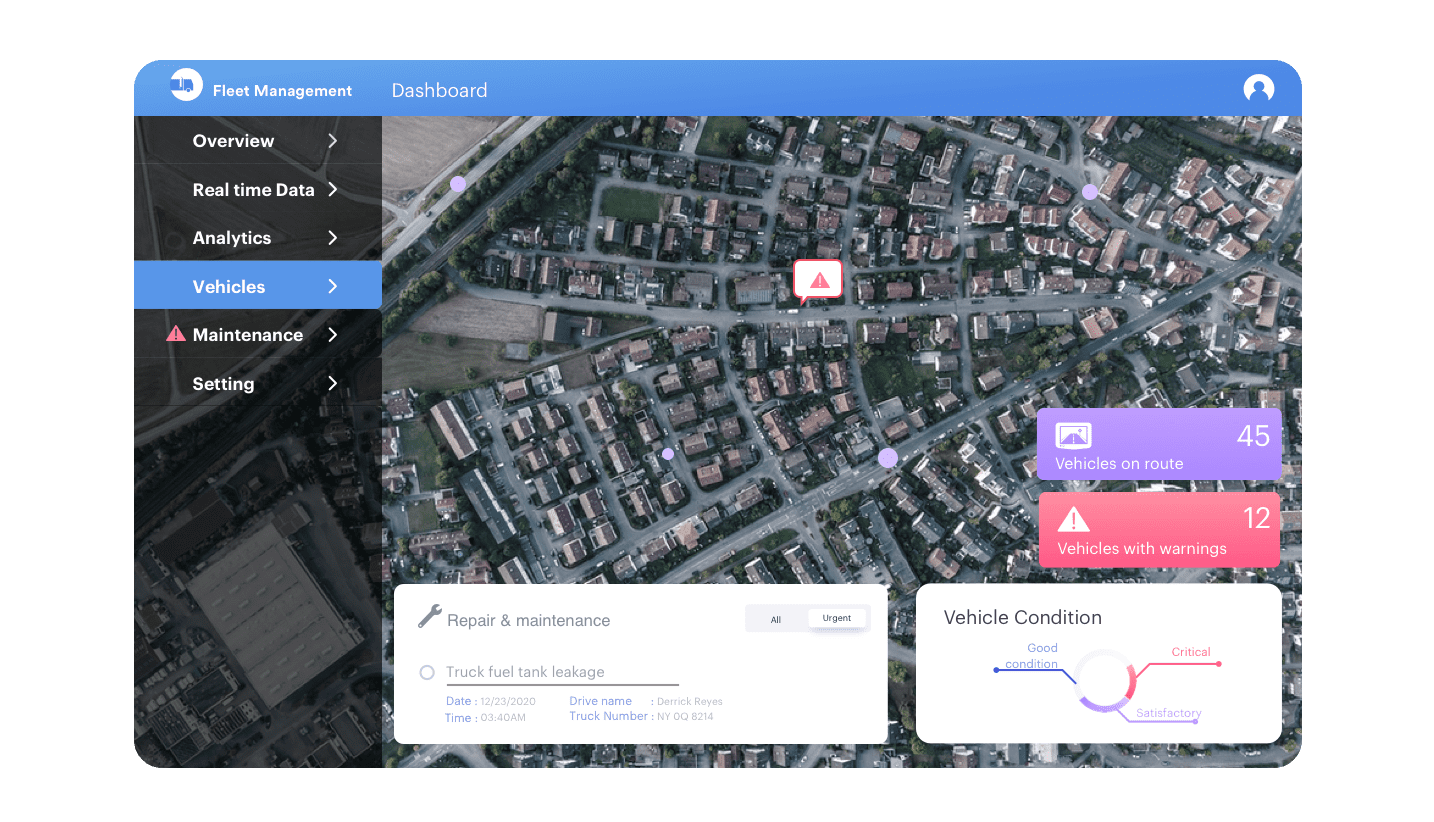 Safer fleets
Safer fleets
Many sensors used in fleet vehicles are placed to make sure the drivers follow safe practices while on the road. You and your fleet managers now have access to tons of data on driver behaviors and vehicle status. What’s even better is that not all the corrections need to be made in the hindsight. Telematics allows you to warn drivers about aggressive maneuvers they might be making, a vehicle they might bump into while parking, punctured tires, equipment failure, and a lot more. The devices also keep a tab on the hours of service (HOS) for drivers, facilitating adherence to the ELD mandate.
Reduced fuel costs
An NACFE report states that fuel accounts for 22% of the overall fleet management cost. And with fuel prices shooting up, you can expect this chunk only to get bigger. Telematics provides you detailed reports on fuel consumption and idling of vehicles. With proper assessment, you can quickly identify and eliminate some instances that lead to unnecessary fuel consumption. Another way telematics brings down fuel costs is by ensuring optimal vehicle performance. We’ve shed more light on it in the following sub-section.
Predictive maintenance
Vehicles are your most valuable asset. And the more you take care of them, the healthier your bottom line gets in the long run. Traditional ways to foresee vehicle maintenance depended either on the number of miles clocked by the vehicle or on the hours/days of usage. However, neither parameter can fully account for the different variables involved in fleet operations. With telematics, prompts are sent when vehicles genuinely need maintenance. This helps improve both the life as well as performance of these carriers. Additionally, it diminishes the avoidable cost of extra and untimely maintenance.
Cheaper insurance
This is the cherry on top when it comes to the benefits of fleet management. Auto insurers now give the option of usage-based insurance (UBI), which relies on the information garnered from the telematics black box. Reliable-driving behavior instills confidence among insurers that they are less likely to face a situation which demands compensation from their side. UBI programs have gotten quite popular in North America lately, and fleet owners from different businesses are cutting costs with cheaper auto insurance – sometimes even upto 40% cheaper with optimum driving scores.
We used telematics to help Scandinavia's second largest general insurer bring transparency in insurance claims
Internet of Things for Internet of Vehicles
Telematics and the internet of things (IoT) are highly intertwined when it comes to fleet-management systems. However, discussing ‘Emerging Technologies in Fleet management’ without appreciating the recent advancements in sensor tech would be a half-measure.
A report from MarketsandMarkets estimates the valuation of the IoT-powered fleet-management market to be USD 8.28 billion by the end of 2021. So what caused the industry behemoths to want to invest so heavily in IoT? Here’s a peep into the reasons behind this shift, and how IoT is transforming the future of fleet management:
IoT owes it to popular smart devices
It’s reported that 11% of units reaching distribution centers turn out to be damaged. That’s a massive dent in the profits of any company and a chronic issue that fleet managers have forever tried to mitigate with little success. IoT brought in sensors that notify managers and owners of every possible package-damaging instance. Be it sudden shocks, fluctuation in temperature and humidity, or even the brightness around the package, nothing escapes the sensors. WIth such technologies, businesses can identify and reduce the factors damaging the goods. Using this information, damaged goods can also be proactively fixed or retracted before they’re shipped out to customers.
It didn’t take IoT very long to find multiple applications in our daily lives. So it’s a no brainer that it made itself useful at managing fleets as well. One of the more obvious impacts of IoT was in the way it changed data collection mode from passive to active. Online connectivity brings information from the driver’s console to the fleet manager’s screen. This allows you to be proactive and plan better instead of reacting to the circumstances as was the case earlier.
Connected mobility is another invaluable addition to fleets thanks again to IoT. It has brought a great deal of safety and efficiency in transportation models. And this is just the beginning according to experts. We could be looking at a future where vehicles seamlessly communicate with traffic lights for constant movement or infrastructures communicating with trucks to help them find a secure parking location.
IoT expands beyond vehicles
While telematics has mostly to do with collecting information from sensors on the truck and transmitting it over to the command center, IoT reaches well beyond the realm of automobiles. It’s not just about the sensors used in vehicles but also about ground staff in fleet hubs.
 Tablets and handheld devices have replaced notepads. The maintenance staff can now quickly scan any automobile part and readily update the central hub’s diagnostic report within a matter of seconds. With swift ground operations, your fleet managers can easily dispatch vehicles and keep up with increasing demands without losing the edge on the quality side of things.
Tablets and handheld devices have replaced notepads. The maintenance staff can now quickly scan any automobile part and readily update the central hub’s diagnostic report within a matter of seconds. With swift ground operations, your fleet managers can easily dispatch vehicles and keep up with increasing demands without losing the edge on the quality side of things.
Big Data and its Impact- Courtesy AI & ML
So far, we’ve discussed how a regular fleet-management operation has many data points, and how the data makes the process more efficient. Yet collecting large volumes of data would be futile without a powerful way to process it – Enter big data! Propelled by artificial intelligence and machine learning, big data is all aces with advanced solutions for fleet management.
Kevin Kelley, VP of Enterprise Fleet Management, told Fleet Financials – “As the amount of data available continues to grow, fleets need to work on organizing the data to help them plan and execute both in the short- and long-term.”
These days, every driver, vehicle, terminal location, route, and even cargo is a potential data set. You just read how telematics helps find the most efficient route and cuts down fuel costs. And this is possible only because we have big data, AI, and ML continuously working toward devising profitable solutions to the usual pain points of fleet management.
Kill many birds with a single stone
Do you know that UPS has a policy of minimizing left turns as much as possible?
They have employed it to save time, improve driver safety, save fuel costs, and reduce carbon emissions. Yeah, all of this with the simple policy of minimizing the left turn of their fleet vehicles. It saved them somewhere between $300 million to $400 million in a short duration after launch. The savings have only compounded ever since. It was big data that revealed this simple trend of left turns and their implications for business.
Artificial intelligence has improved exponentially since UPS came up with this policy. So as a modern-day fleet owner, you can bring about remarkable improvements in your business using AI. Be it finding the most efficient routes, managing drivers, creating a maintenance schedule, deciding the order of delivery, reducing the number of empty fleet vehicles on the road, and much more, you can put big data to work on any bottleneck.
Make back-office operations a cakewalk
As a fleet owner, you must be processing loads of documents daily. Dealing with vendors, OEMs, clients, insurance companies, and many other parties entails mountains of paperwork. And the more your business prospers, the higher the pile gets. So many companies now rely on ML algorithms to share some of this load while processing documents.
At the end of the day, documents are data. So why not employ the best available methods to handle said data? You can develop algorithms that swiftly go through documents and extract useful information. ML has brought a great deal of organization to many logistics companies by helping them process documents like never before.
The use of ML and AI also extends to processing sensitive legal documents and vetting for words and phrases that can be deemed harmful for the business. The high accuracy and reliability of these techs have made them a go-to option for most businesses.
Augmented Operations With Augmented Reality
AR is another up and coming technology set to play a massive role in the future of fleet management. From the point of loading the vehicle to driving it safely on the road, AR finds applications in virtually every aspect of fleet management. Let’s have a peek into the world of opportunities that come with this tech:
Easier maintenance and repair
In the IoT section, we mentioned using scanners to check and update the status of various automobile parts. AR takes it one step further with wearable tech. Imagine maintenance staff wearing smart glasses, which tell them everything about a select part of the vehicle just by looking at it. This makes regular inspections a piece of cake and fast-tracks the normal repair operations.
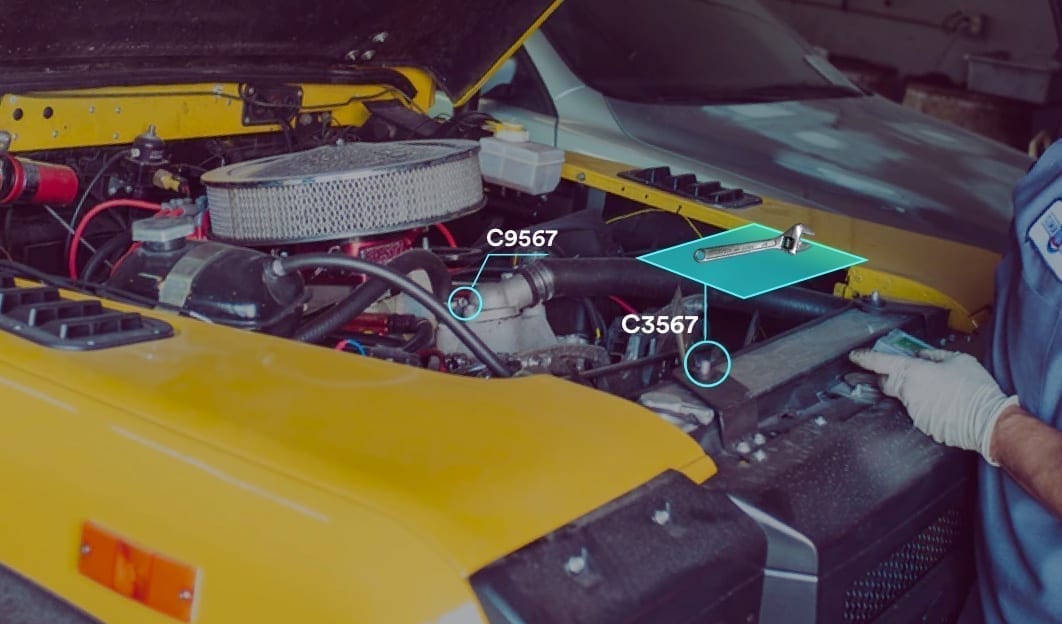 Driver training and assistance
Driver training and assistance
Driving fleet vehicles is no joke. The driver is on the steering for extended periods while ensuring safe driving standards with precious cargo behind them. Augmented Reality allows you to train them in a simulated environment at a very low cost. Another merit of AR involves providing the driver with a more comprehensive view of what’s happening on the road, thus improving the operation’s overall safety and efficiency.
Simplified freight loading
Scanning every item in cargo and then loading it accurately is time consuming and complicated. With AR glasses, supervisors can readily know every item’s status in the freight, and where it is supposed to go inside the truck for easier unloading.
When it comes to its applications in fleet management, Augmented Reality is still in its infancy. But it’s predicted to be more relevant in the future, so it makes sense to start integrating it into your fleet management operations now.
Blockchain Brings Transparency and Accountability
Mention blockchain and an average Joe would think Bitcoin. Even though it’s an excellent application of the tech in fleet management, we are not talking about using cryptocurrency to make payments. Simply put, blockchain is a way of record keeping where record of transactions are available to all the participants – making it virtually impossible to meddle with.
Since fleet management usually involves various kinds of record keeping, blockchain integrates with it in multiple ways. Let’s look at some of the ways blockchain can come in handy for fleet management:
Payments made easy
You can create transparent, automated payment systems using blockchain. This makes the transaction part of the business supereasy for you as well as other parties such as vendors, suppliers, owners, and fleet managers. This can be done by creating smart contracts which automatically initiate transactions upon delivery completion. Adding to the overall efficiency of the process, blockchain also removes unnecessary middlemen and third parties from the equation.
Unalterable record keeping
Be it keeping track of vehicle maintenance and service, driver’s history, information about delivery routes, or even record of all the cargo displaced by your fleet, blockchain does it all in the most secure, detailed, and transparent way possible. With the power of immutable records at your side, you’re all set to make better business decisions.
“EDI is a universal mechanism, but it doesn’t quite accomplish things. If someone wants to send cargo data, there is just one way to do it with the blockchain,” said Vasanth Srinivasan, VP of Enterprise Architecture, Transportation, Trimble to Truckinginfo.
Another advantage of this decentralized ledger system is that you can easily retrace your steps if something goes wrong. For instance, if you get reports of a faulty product from a terminal point, blockchain would take you back to its source in a matter of minutes.
Even though blockchain faces certain challenges such as standardization in record-keeping methods and acceptance of tech from various industries, most experts believe that it will play a significant role in fleet-management solutions.
Autonomous Vehicles Qualify Automatically
Would a discussion on emerging tech in fleet management be complete without bringing up autonomous vehicles? We think not!
Autonomous vehicles have captured the imagination of regular folks and fleet managers alike. The benefits of a computer driving the vehicle are obvious, especially for commercial fleets. Self-driving vehicles don’t need long breaks, are safer on the road, and help cut down costs.
Waymo, which is already quite popular for its fleet of self-driving cabs, recently started testing autonomous trucks. “Fatalities from large truck crashes have been increasing over the decade, while the overall crash fatalities have decreased during that period. So our goal really is to improve the safety on the road by making every mile traveled with Waymo Driver safer, because it doesn’t get tired or distracted,” said Vijaysai Patnaik, product lead for Waymo Via trucking, in a media brief.
There are several other companies making significant strides towards perfecting autonomous vehicles. Be it Tesla Semi or Mercedes-Benz’s autonomous future truck set to launch in 2025, autonomous vehicles are the next big thing for the future of fleet management.
All technologies mentioned in this article are capable of single-handedly transforming the fleet-management space. But fleet owners, like you, aren’t necessarily looking for revolutions so much as for methods of profitably managing the fleet and increasing ROI. Doing so requires the perfect balance of all these technologies put together into a comprehensive fleet-management package.
And to help you with that, we’ve created a comprehensive ebook that goes into the nuances of creating a customized fleet management solution. It will tell you how to implement preventive maintenance, centralize fleet & data expenses, streamline fleet operations, so much more.
Having the knowledge to build the custom fleet management software is just one part of the equation. You’d also need a skilled team with proven expertise in custom software development. Simform brings to you a pool of talented developers and managers that can extend your team and augment their development capabilities. Feel free to reach out to us with your business-specific needs and we’ll help you chalk out the perfect software solution for you.
